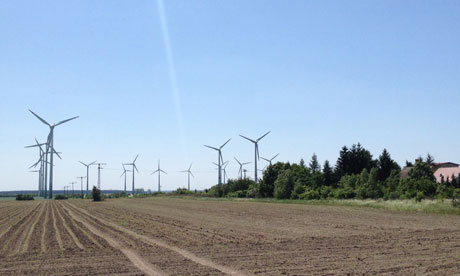Germany's renewable energy revolution leaves UK in the shade
The country expects renewables to contribute 35% electricity by 2020 – no matter what the cost.

The village Feildheim, near Berlin, gets all its energy from 43 wind turbines dotting the fields around it and a biogas plant that turns farmyard manure into gas-powered electricity. Photograph: Damian Carrington for the Guardian
The blazing blue skies that Germany baked under last weekend added a fresh gleam to the nation's renewable energy revolution: a new world record for solar power generation, equivalent to 20 nuclear power stations. It is the battle between nuclear, fossil fuels and renewables, and between the big utilities and the community-owned renewables eating into their profits, that has driven Germany's radical energy transformation to the top of its political agenda, with success seen as vital to chancellor Angela Merkel's hopes of re-election in 2013.
"We are still occupied by the four powers," says Werner Frohwitter, standing in the harsh sunlight below an 85-metre tall wind turbine in the flat east German countryside – referring to the four giant energy companies that have carved up the nation. They are RWE, E.ON,Vattenfall and EnBW.
The hamlet of Feldheim, set amid rippling rye fields and foxy-barked forests, rebelled. Its 128 inhabitants now get all their power by tapping into some of the 43 turbines dotting the fields around, some solar panels and a plant that turns farmyard manure into gas-powered electricity. When leasing of the local grid that connects the village's squat, steep-roofed homes was made prohibitively expensive, Frohwitter's company,Energiequelle, built its own.
Germany and UK energy statistics
Germany
UKPopulation (millions) 82 62
Electricity production in 2011 (Twh) 612 317
Individual or community owned renewable energy capacity 2010 (%) >65% <10%
Renewable electricity 2011 (%) 20 9.5
Nuclear electricity 2011 (%) 18 19
Nuclear phase out date 2022 none
Installed renewable capacity end 2010 (GW) 54 9
Installed nuclear capacity end 2010 (GW) 20 10
Installed nuclear capacity end 2011 (after Germany phase-out decision) (GW) 12 10
2020 renewable electricity target (%) 35 30
2050 renewable electricity target (%) 80 none
2050 renewable energy target (%) 60 none
2020 greenhouse gas emissions cut target 40 34
2050 greenhouse gas emissions cut target 80-95 >80
Primary energy demand change by 2050 (%) ref 2008 -50 -14 to -43
Electricity demand change by 2050 (%) ref 2008 -25 +33 to +66
http://www.decc.gov.uk/en/content/cms/news/pn12_032/pn12_032.aspx
http://www.world-nuclear.org/info/inf43.html
http://www.world-nuclear.org/info/inf84.html
Feldheim's war of independence was total, but power has been sweeping to the people across Germany: 20% of electricity was generated from renewables in 2011, the majority from home solar panels, wind turbines in farmer's fields and biogas plants fed by local farms. The renewable roll-out accelerated when the national loathing of nuclear power reached critical mass after the Fukushima disaster, but less than a tenth of renewables are being installed by the big four utilities.
"The new energy system has a social dimension and if you don't bring it to the people it will not happen," says Josef Göppel, a former Bavarian forester and conservative member of parliament in the governing CDU/CSU party. "The majority of the population in Bavaria have invested in renewables, so you cannot move back on it now."
Göppel, something of a renegade in his party, says to be an environmentalist and conservative is not a contradiction in Germany: "They want to be independent in my village, they say 'I want to control my own energy'." Andreas Kramer, director of the Ecologic Institute, suggests another reason for the popularity of renewables: "People hate the big four energy companies – they know when they are being milked."
However, many in the governing coalition, as well as the big energy and industrial companies, argue that a decentralised system powered byrenewable energy would be too expensive and insecure to replace the current centralised one, which is based on a few large coal, gas and nuclear plants. But the big four have had no option but to accept Germany's new direction. "We accept the democratic political majority's decision," says a spokesman for E.ON, which is now concentrating on large offshore wind plants.
Opposition MP, Ulrich Kelber, of the Social Democrats, says: "Many cannot imagine that a decentralised energy system is as secure as a centralised one, yet we are all hooked on a decentralised system called the internet: that's what we need to do in energy policy."
The ambition of Germany's change of direction, universally called theEnergiewende – energy transformation – is huge. It aims to cut overall energy consumption by 50% by 2050 and electricity consumption by 25%: the UK, which uses half the energy, is aiming for an increase in electricity use between 33% and 66%. Germany also aims to produce 80% of electricity from renewables by the same date.
The nation's energy aspiration took a sharp turn – "wende" means a 90 degree tack in sailing – when one year ago it closed half its nuclear power plants after Fukushima, pledging to shutter the rest by 2022. With a hostile public also virtually ruling out fracking for shale gas or capturing and burying emissions from fossil fuel plants, renewables and energy efficiency are almost the only options left.
And yet, as a result of the other great nuclear disaster, Chernobyl, that future is one for which Germany has been preparing for two decades. The 1986 catastrophe led directly to the founding of the first environment ministry in Germany and out of that, in 1990, came the first feed-in-tariffs (Fits) – long-term, guaranteed payments for small-scale renewable energy, which ignited the renewables boom.
The political importance of the Energiewende, before the 2013 federal elections, is huge. "Apart from the saving of the euro, the successful implementation of energy policy is the second biggest challenge for Angela Merkel's government," a senior government official told the Guardian.
Polling shows German citizens are indeed seriously concerned, but rather than losing faith they are worried that the changes needed to accommodate large amounts of variable renewable energy on the grid, in particular thousands of kilometres of new power lines and the ramping up of energy storage, are not happening quickly enough.
However, another concern is the rising cost of the Fits scheme that has driven Germany's huge renewable roll out: it now costs bill payers €14bn a year. An official at the economic ministry, which uneasily shares responsibility with environment for energy policy, warns that a tipping point will come when consumers will refuse to pay more for new renewables.
But that point has yet to be reached: proposals to slash the Fit and to cap the amount paid out for the first time have failed, so far, to get through parliament. The crunch will come in the next month, with Merkel determined to thrash out a deal on the policy before the summer recess, with the solar industry already reeling from four of the five big panel manufacturers collapsing in the face of cut-price competition from China. One senior academic, who views the Fit as wasteful in economic terms, criticises the subsidies as the "greatest technology transfer scheme [to China] in history".
A further criticism is that all energy bill payers, even the poor, pay for the Fits that put solar panels on the roofs of the "dentists", the phrase used by Germans to evoke middle-class wealth. But Greenpeace's Tobias Münchmeyer notes that major industries that have heavy power use are exempt entirely from paying Fits.
The economic attacks also extend to Germany's dark environmental secret: its opposition to proposed European targets for energy efficiency. The nation has very tough domestic ambitions on efficiency – it wants every building to be zero-carbon by 2050, for example – but the land of manufacturing titans such as BMW, Bayer and BASF is reluctant to sign up to strict limits. "We have a problem that this may be counterproductive to economic growth, so we are in very difficult negotiations," says the economics ministry official.
Nonetheless, Germany's sustainable energy ambition remains strong. It wants to move from 20% renewable electricity to 35% by 2020, Two-thirds of the nation believe this will be achieved on time, or early. "That is not starry eyed, that is based on real experience of our renewable roll-out," says Sascha Müller-Kraenner, executive director of the Nature Conservancy in Europe. Dagmar Dehmer, environment correspondent at the daily newspaper Berliner Tagespeigel agrees: "We always trust our engineers."
The contrast with the UK, where renewables contributed 9.5% of electricity in 2011, is stark. Rainer Hinrichs-Rahlwes, head of the German renewable energy federation, blames the absence of Fits for individuals and community groups until 2010, 20 years after Germany, and the earlier policy forcing major energy companies to ensure a chunk of their power generation was renewable, which he says meant small-scale renewable energy generators weren't considered. In Germany 65% of renewables are owned by individuals or communities: in the UK the figure is less than 10%.
Germany's first environment minister was Klaus Töpfer, a conservative. Today, he is clear about the challenge posed by Energiewende: "We have to prove this can be successful - and there are lots of interests against it - but are we fully aware that if we fail it will be very damaging to Germany's image in the world."
Back in the tiny village of Feldheim, Frohwitter acknowledges that there is still some opposition to local energy independence, despite it having cut electricity bills by a third. "Of course, you always have some people who don't want to join in," he says. "E.ON still has two or three customers here."

No hay comentarios:
Publicar un comentario